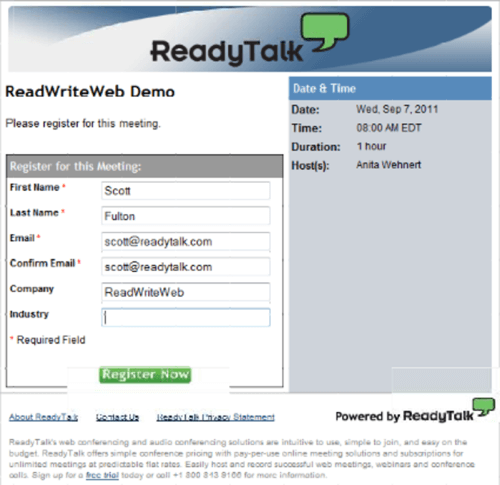If you’ve seen the ReadyTalk conferencing platform at work, you know it has one key feature that distinguishes it quite well over certain conferencing competitors: It can run entirely in Flash. That means it’s not bound to Java, and up to now, it’s meant that ReadyTalk runs well with minority browsers such as Apple Safari for Windows, and Opera.

What it means today, though, is something quite different and a sign of the new times we live in: A new version of ReadyTalk for Salesforce, released this morning at the Dreamforce conference in San Francisco, embeds both conference ability and meeting coordination not into a Web browser, but instead into the fast-growing, cloud-based CRM platform.
The Salesforce app is the first to use the ReadyTalk API, released last month, to come directly from ReadyTalk itself. The platform was designed to give developers direct access to the stages and steps involved in crafting a conferencing workflow, including generating the invitations, accepting registrations, automating reminders to participants, and distributing post-event surveys. All of these stages have been implemented in the Salesforce rendition, so that users can conduct conferencing workflows with Salesforce contacts.

Anita Wehnert, who directs product marketing for ReadyTalk, gave RWW a complete demonstration. “The whole goal with this application,” she tells us, “is to make things easier for people doing scheduling of meetings or webinars or online training sessions or sales demos. We automate getting that data into Salesforce versus having it locked into a conferencing system.”
The initial screen, shown here, reveals a very Salesforce-friendly environment with a ReadyTalk tab added to the usual mix of Chatter, Leads, Contacts, and Campaigns. Here, a user can see the ongoing status of meetings already scheduled, by both the user and others throughout the organization.

The Conference Center screen (familiar to anyone who’s used the standard ReadyTalk UI) is where a new meeting is scheduled. It’s actually a view of the continually updated Conference Center Web app, within what Web app developers call an IFRAME element. All the other elements of this app, Wehnert tells us, were implemented in Force.com. You may add any number or sequence of fields to the registration form. After that’s set up, you then import the meeting into Salesforce using the controls in the Meetings tab.
Once imported, all the information may be shared explicitly with others within the organization – for instance, they may see whom you’ve invited and whether they’ve responded, if you so desire. It’s important to note here that the meeting creation data is registered and entered into ReadyTalk’s database first, and then the Salesforce app uses the ReadyTalk API to import the data and populate the Salesforce database.
“The Salesforce application is going to sync with our database once per hour,” notes Wehnert, “or every time I click on that Sync with ReadyTalk button.” Individuals are invited to a meeting from within ReadyTalk, and they can be sourced from the Salesforce database. When that happens, those invitees are then synced with ReadyTalk, again by way of the API. Invitees who happen to be using Salesforce will see a form like the figure below.

The various activities triggered by the application are tracked through Salesforce Chatter, its built-in messaging service. Any Salesforce user will be familiar with the output, which looks a bit like one’s Twitter page:

Licensing this software will be a fully automatic deal. “We offer the ReadyTalk for Salesforce AppExchange application as a value-add to our customers,” remarks Wehnert, “so any of our customers are free to use it. There’s no charge for downloading the application and installing it from AppExchange, and there’s no additional fee for the software. ReadyTalk offers its conferencing service in tiers, with the fee per minute starting at 20¢, and an option to pay a flat fee of $49 per month for up to 25 participants, or $99 per month for up to 3,000.
“Salesforce has a well-documented API; we worked with a third party to develop the integration,” Wehnert tells RWW. “We’ve been working over the last two years to make sure we got it right, but we think it’s great that Salesforce can help companies like ReadyTalk to build AppExchange applications.”

















